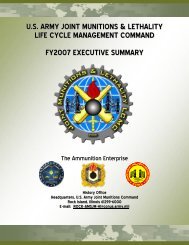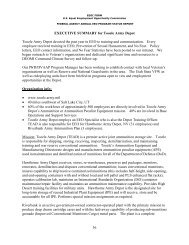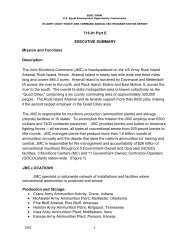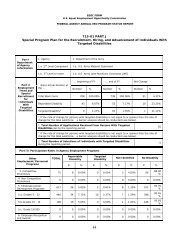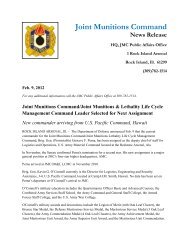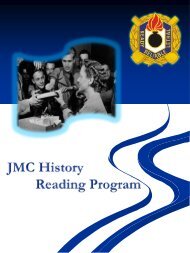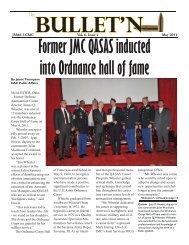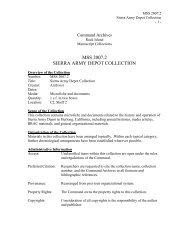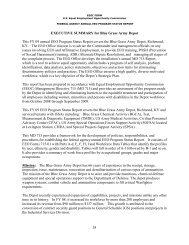History of the Ammunition Industrial Base - JMC - U.S. Army
History of the Ammunition Industrial Base - JMC - U.S. Army
History of the Ammunition Industrial Base - JMC - U.S. Army
You also want an ePaper? Increase the reach of your titles
YUMPU automatically turns print PDFs into web optimized ePapers that Google loves.
<strong>of</strong> <strong>the</strong> <strong>Army</strong> depot system became acute <strong>the</strong> Services became concerned about reducing <strong>the</strong><br />
stockpile, because it became more difficult to have <strong>the</strong>ir preferred stock issued rapidly. 140 The<br />
bottom line was that as <strong>Army</strong> budgets decreased, <strong>the</strong> ammunition portion <strong>of</strong> <strong>the</strong> budget also grew<br />
smaller and <strong>the</strong> SMCA was unable to maintain <strong>the</strong> budget levels to adequately maintain <strong>the</strong><br />
stockpile.<br />
On several occasions, Congress became involved in trying to correct <strong>the</strong> funding issues.<br />
At one point <strong>the</strong>y issued a report on <strong>the</strong> growing demilitarization requirements and directed<br />
minimum annual expenditures to reduce <strong>the</strong> stockpile. In ano<strong>the</strong>r instance, Congress directed<br />
GAO investigations on <strong>the</strong> management <strong>of</strong> excess stocks. One GAO conclusion was that <strong>the</strong><br />
Services had no interest in directing or funding <strong>the</strong> disposal <strong>of</strong> excess as <strong>the</strong>y were not paying <strong>the</strong><br />
costs <strong>of</strong> storage. It was, perhaps, <strong>the</strong> lack <strong>of</strong> funds that led to reductions in force in <strong>the</strong><br />
ammunition community in <strong>the</strong> late 1980s and early 1990s. These reductions led to slower<br />
processing times that were noted by Service leaders, but never fixed. 141<br />
Despite problems and concerns, <strong>the</strong> SMCA experienced increased effectiveness and<br />
efficiency in many areas. Management <strong>of</strong> all wholesale stocks by one entity improved<br />
effectiveness and saved money. The ability to see stocks and suggest that excess be transferred<br />
to ano<strong>the</strong>r Service instead <strong>of</strong> buying new rounds saved hundreds <strong>of</strong> millions <strong>of</strong> dollars. The<br />
centralization <strong>of</strong> buys under Conventional <strong>Ammunition</strong> Working Capital Fund (CAWCF)<br />
reduced competition between <strong>the</strong> Services and created magnitudes <strong>of</strong> scale efficiencies. The<br />
Integrated Conventional <strong>Ammunition</strong> Procurement Plan (ICAPP), created in 1981, fostered<br />
cooperation between <strong>the</strong> Services while forging more effective use <strong>of</strong> <strong>the</strong> government and<br />
commercial production base. The Integrated Conventional <strong>Ammunition</strong> Maintenance Plan<br />
(ICAMP), created in 1983, provided line-by-line analysis <strong>of</strong> maintenance requirements across<br />
<strong>the</strong> Services and allowed for better forecasting and smoothing <strong>of</strong> maintenance requirements at<br />
<strong>the</strong> depots. The main intent <strong>of</strong> creating <strong>the</strong> SMCA, increased effectiveness and efficiency in <strong>the</strong><br />
management <strong>of</strong> conventional ammunition was accomplished. 142<br />
Throughout <strong>the</strong> 1980s, <strong>the</strong> government owned base was revitalized and modernized, but<br />
this was due more to a general influx <strong>of</strong> funding during <strong>the</strong> Reagan Administration buildups than<br />
a DoD or DA level systemic attempt to improve management <strong>of</strong> <strong>the</strong> base. The general increase<br />
in funding and activity masked <strong>the</strong> problems <strong>of</strong> managing <strong>the</strong> base, stockpile balance, unsteady<br />
requirements, and fluctuating production schedules. As soon as <strong>the</strong> Cold War ended, budgets<br />
began to drop and <strong>the</strong> same issues returned to <strong>the</strong> forefront.<br />
In <strong>the</strong> mid 1990s, <strong>the</strong> GAO published several new reports on DoD‟s management <strong>of</strong><br />
ammunition. Reports on small arms ammunition management (1995), artillery shell production<br />
(1996), and <strong>the</strong> ability <strong>of</strong> <strong>the</strong> industrial base to meet requirements (1996) were generally<br />
favorable. However, each report mentions GAO concerns on management <strong>of</strong> excess inventory in<br />
<strong>the</strong> wake <strong>of</strong> post-Cold War drawdowns. In June 1996, after a two year investigation, <strong>the</strong> GAO<br />
published a report on DoD‟s management <strong>of</strong> excess ammunition. GAO report GAO/NSIAD-96-<br />
129, “Defense <strong>Ammunition</strong>: Significant Problems Left Unattended Will Get Worse” was critical<br />
140 EDCA and AMCCOM Annual Reports, 1981-1994.<br />
141 Ibid. See also GAO Report GAO/NSIAD-96-129, “Defense <strong>Ammunition</strong>: Significant Problems Left Unattended<br />
Will get Worse,” June, 1996.<br />
142 The annual reports <strong>of</strong> SMCA activities, prepared by <strong>the</strong> EDCA, contain figures on cost avoidance. See <strong>the</strong><br />
annual reports for specific numbers on cost avoidance and savings.<br />
45



